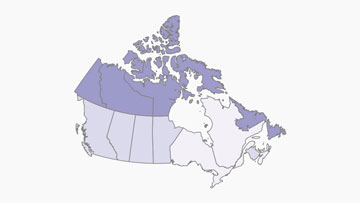Introduction
This section is to confirm we have made contact with the correct individual.
1. What is your date of birth?
2. Are you [AGE] years old?
3. What is your age?
4. What is the highest certificate, diploma or degree that you have completed?
- Earned doctorate
Help text: e.g., Ph.D., Ed.D.
- Master's degree
Help text: e.g., M.A., M.Sc., M.Ed., M.B.A.
- Degree in medicine, dentistry, veterinary medicine or optometry
Help text: e.g., M.D., D.D.S., D.M.D., D.V.M., O.D.
- University certificate, diploma or degree above the bachelor's level
- Bachelor's degree
Help text: e.g., B.A., B.A. (Hons), B. Sc., B.Ed., LL.B.
- University certificate or diploma below the bachelor's level
- College, CEGEP or other non-university certificate or diploma (other than trades certificates or diplomas)
- Trades certificate or diploma
- High school diploma or a high school equivalency certificate
- Less than high school diploma or its equivalent
5. Within the last month, were you considered a part of any of the following groups?
Select all that apply.
- Ph.D. student
- Postdoctoral fellow at a postsecondary institution
- Researcher at a college
Help text: Exclude research assistant positions as part of an academic program (e.g., postdoctoral fellow, Ph.D. student, Master's student, Bachelor's student).
- Researcher at a university
Help text: Exclude research assistant positions as part of an academic program (e.g., postdoctoral fellow, Ph.D. student, Master's student, Bachelor's student).
- Professor, instructor or teacher at a college
Help text: Include sessionals and part-time lecturers.
Exclude teaching assistant positions.
- Professor, instructor or teacher at a university
Help text: Include sessionals and part-time lecturers.
Exclude teaching assistant positions.
- None of the above
6. In which type of institution do you spend the most time?
When responding to the next questions, consider only your experience as a [professor, instructor, teacher, or researcher / postdoctoral fellow / Ph.D. student] at a [college / university].
7. What is the name of the [college / university] where you are a [professor, instructor, teacher, or researcher / postdoctoral fellow / Ph.D. student]?
If you [work / study] at more than one institution, please refer to the institution where you spend the most time.
Note: If the institution is not listed, select 'Other'.
Background
8. What is [your field of study / the field of study you teach or research] at [institution name]?
Specify the subject in which you spend the largest portion of your time.
If you are on leave, report the subject that you would have been [teaching or researching / studying]
9. In what year did you begin your [current Ph.D. studies / current postdoctoral position]?
Enter the date you originally started in the program. If you have taken a break, enter the original start date.
Year
- Select from : 2019 to 1990, or Before 1990
10. In what year do you expect to complete your [current Ph.D. studies / current postdoctoral position]?
[If end date is unknown, please provide the end date of your current contract.]
Year
- Select from : 2019 to 2029, or 2030 or later
Ph.D. and postdoctoral fellow
11. Have you ever received federal research funding, a federal scholarship, or a federally funded fellowship as part of your [current Ph.D. studies / current postdoctoral position]?
e.g., Canada Graduate Scholarship, SSHRC Postdoctoral Fellowship.
Exclude entrance scholarships and bursaries from your institution.
From which federal agency did you receive this funding?
Select all that apply.
- Social Sciences and Humanities Research Council (SSHRC)
- Natural Sciences and Engineering Research Council (NSERC)
- Canadian Institutes of Health Research (CIHR)
- Other
Specify other federal agency
12. As part of your [current Ph.D. studies / current postdoctoral position], have you ever been paid to work on a federally-funded research project led by a researcher at your institution?
e.g., you were a research assistant to a researcher leading a project-based grant, from a federal organization such as SSHRC, NSERC, or CIHR.
Exclude entrance scholarships and bursaries from your institution.
- Yes
- No
- I worked on a research project, but I do not know if it received federal funding
13. Have you ever received non-federal research funding as part of your [current Ph.D. studies / current postdoctoral position]?
e.g., funding by provincial or territorial governments, foreign governments, businesses, not-for-profit organizations, third-party individuals.
Exclude entrance scholarships and bursaries from your institution.
14. After completing your [current Ph.D. studies / current postdoctoral position], are you likely to work as a professor, instructor, or researcher at a postsecondary institution in Canada?
- Yes (Go to Q15)
- No
- Unsure
For what reasons?
Select all that apply.
- Lack of career prospects
Help text: e.g., opportunities for tenure
- A career at a postsecondary institution is too demanding
Help text: e.g., too much pressure to publish, work-life balance, pressure to apply for funding
- I plan to work at an institution outside Canada
- I would prefer to conduct research in the private sector
- I would prefer to conduct research in the public sector
- I am interested in a career outside of research and academia
- Other
Specify the other reasons
Research, teaching, and industry
15. In the last five years, have you applied for any research funding as a principal or co-principal investigator?
e.g., NSERC Discovery Grant, SSHRC Connection Grant, CIHR Project Grant, Canada Research Chair, provincial or territorial governments, foreign governments, businesses, not-for-profit organizations, third-party individuals
16. In the last five years, did you receive any research funding as a principal or co-principal investigator?
e.g., NSERC Discovery Grant, SSHRC Connection Grant, CIHR Project Grant, Canada Research Chair, provincial or territorial governments, foreign governments, businesses, not-for-profit organizations, third-party individuals
What was the source of the research funding received?
- Federal research funding
Help text: e.g., NSERC Discovery Grant, SSHRC Connection Grant, CIHR Project Grant, Canada Research Chair
- Non-federal research funding (Go to Q19)
Help text: e.g., provincial or territorial governments, foreign governments, businesses, not-for-profit organizations, third-party individuals
- Both
17. In the last five years, how much did you receive in federal research funding as a principal or co-principal investigator?
Federal research funding received
e.g., NSERC Discovery Grant, SSHRC Connection Grant, CIHR Project Grant, Canada Research Chair.
Round to the nearest CAN$.
When precise figures are not available, please provide your best estimate.
18. From which federal agencies did you receive this funding?
Select all that apply.
- Social Sciences and Humanities Research Council (SSHRC)
- Natural Sciences and Engineering Research Council (NSERC)
- Canadian Institutes of Health Research (CIHR)
- Other
Specify the other federal agency
19. In the last five years, how much did you receive in research funding from non-federal sources?
Non-federal research funding received
e.g., Funding from provincial or territorial governments, foreign governments, businesses, not-for-profit organizations, third-party individuals.
Round to the nearest CAN$.
When precise figures are not available, please provide your best estimate.
The next few questions are about your work activities.
20. In addition to your current position as a [professor, instructor, teacher, or researcher / postdoctoral fellow / Ph.D. student] at [institution name], did you have other jobs or businesses within the last month?
Include other positions at [Institution name], or other institutions, as well as any other jobs or businesses.
21. Including your current position as a [professor, instructor, teacher, or researcher / postdoctoral fellow / Ph.D. student] at [institution name], how many jobs or businesses did you have within the last month?
If you were self-employed, select the number of different businesses, not the number of contracts for one single business. For example, a self-employed consultant who is also a professor would answer two jobs or businesses.
Exclude unpaid or volunteer positions.
Total number of jobs or businesses
22. [Is this job or business / Are any of these jobs or businesses] in the same field that you [study / teach or research]?
[You previously indicated your field of study was the following: [Q8]]
23. In a typical work week, how many hours do you spend on the following activities?
Include all hours worked, both paid and unpaid.
a. In-class teaching duties as a [professor, instructor, teacher, or researcher / postdoctoral fellow / Ph.D. student] at [institution name]
e.g., in-class hours.
b. Other teaching duties as a [professor, instructor, teacher, or researcher / postdoctoral fellow / Ph.D. student] at [institution name]
e.g., preparation, office hours, grading, graduate student supervision.
c. Research activities as a [professor, instructor, teacher, or researcher / postdoctoral fellow / Ph.D. student] at [institution name]
e.g., contributions to knowledge, publications, oral presentations, community based scholarship, writing of grant applications, time in the lab, conducting research, presenting findings, report writing.
d. Service and administrative activities as a [professor, instructor, teacher, or researcher / postdoctoral fellow / Ph.D. student] at [institution name]
e.g., committee involvement, supervising student clubs, peer review and editorial duties, involvement in professional organisations.
e. Other employment
Include different roles, different institutions, or other jobs
24. In the last five years as a [professor, instructor, teacher, or researcher / postdoctoral fellow / Ph.D. student] at [institution name], have you been involved in an academic or applied research project?
e.g., engaging in research at your postsecondary institution or in collaboration with industry.
Exclude participation as a research subject.
Why not?
Select all that apply.
- My management did not approve my participation
- I was not aware of opportunities
- Opportunities were not available in my preferred language
- I was not interested
- I did not have time because of my workload as a [professor, instructor, teacher, or researcher / postdoctoral fellow / Ph.D. student] at [institution name]
- Family responsibilities
Help text: e.g., child care
- It is not in my job description
- I have another job that takes up more of my time
- Accommodations I needed due to a disability were not provided
Help text: e.g., modified duties, human support, specialized equipment, adapted workspaces
- Other
Specify the other reason you have not been involved in an academic or applied research project
Professional development
25. Within the past two years, as a [professor, instructor, teacher, or researcher / postdoctoral fellow / Ph.D. student] at [institution name], did you participate in any of the following professional development opportunities?
[Exclude coursework and training as a requirement of your Ph.D. studies.]
Select all that apply.
- Conferences, workshops, or tradeshows
- Training
- Further education
- Mentoring programs
- Other
Specify other professional development opportunities
OR
- None
26. What was the source of the funding for the professional development opportunities you participated in as a [professor, instructor, teacher, or researcher / postdoctoral fellow / Ph.D. student] at [institution name]?
Select all that apply.
- [institution name]
- Research funding
- Bursary
- Self-funded
- Not applicable (there were no costs)
- Other
Specify who funded these activities
27. Within the past two years, did you feel you missed out on any professional development opportunities?
Professional development opportunities
Include conferences, workshops, tradeshows, training, further education, mentoring programs, etc.
Include opportunities you were interested in but did not request, or opportunities you requested and were not approved.
Why did you feel you missed out on these professional development opportunities?
Select all that apply.
- My management or supervisor would not approve my participation
- Someone else was selected
- I did not have time because of my workload as a [professor, instructor, teacher, or researcher / postdoctoral fellow / Ph.D. student] at [institution name]
- Family responsibilities
Help text: e.g., child care
- I could not afford it
- Opportunities were not available in my preferred language
- Accommodations I needed due to a disability were not provided
Help text: e.g., modified duties, human support, specialized equipment, adapted workspaces
- Other
Specify the reason why you did not participate
28. As a [professor, instructor, teacher, or researcher / postdoctoral fellow / Ph.D. student] at [institution name], do you currently have a mentor?
A mentor is an experienced and trusted advisor outside of formal supervisory relationships.
Include structured mentoring programs and informal relationships.
29. As a [professor, instructor, teacher, or researcher / postdoctoral fellow / Ph.D. student] at [institution name], are you a mentor to [a junior employee, postdoctoral fellow, or student / a junior employee or student / another student]?
A mentor is an experienced and trusted advisor outside of formal supervisory relationships.
Include structured mentoring programs and informal relationships.
Employment, salary, and benefits
30. In the last 12 months, how many weeks were you employed as a [professor, instructor, teacher, or researcher / postdoctoral fellow / Ph.D. student] at [institution name]?
Include those weeks in which you:
- were on vacation or sick leave with pay;
- worked full time or part time;
- worked for wages or salary.
If you are on leave, report the weeks that you would have been working.
- Select number of weeks
OR
- None
31. During most of those weeks, did you work full time or part time as a [professor, instructor, teacher, or researcher / postdoctoral fellow / Ph.D. student] at [institution name]?
If you worked full time and part time for an equal number of weeks, indicate your most recent employment status.
If you are on leave, report the full-time or part-time status that you would have been working.
- Full-time (30 hours or more per week) (Go to Q34)
- Part-time (less than 30 hours per week)
32. If given the opportunity, would you prefer to work full time for the full year?
Full time for the full year is considered 30 hours or more per week and 49 weeks or more per year, including vacation or sick leave with pay.
33. What is your tenure status?
- Tenured
- Leading to tenure, probationary (Go to Q35)
- Non-tenured staff or non-tenure track (Go to Q34)
Help text: This Includes annual, sessional or other definite term contracts, visiting staff, and continuing staff.
How many years after your first tenure-track appointment did you obtain tenure?
When precise figures are not available, please provide your best estimate.
34. How long is the term of your current contract as a [professor, instructor, teacher, or researcher / postdoctoral fellow / Ph.D. student] at [institution name]?
Report the total duration of the term.
- Number of months
OR
- Permanent or indeterminate
35. How much did you earn in the last 12 months as a [professor, instructor, teacher, or researcher / postdoctoral fellow / Ph.D. student] at [institution name], before taxes and other deductions?
Exclude overtime pay, commissions, or bonuses.
'Before taxes and other deductions' refers to your gross wage or salary.
When precise figures are not available, please provide your best estimate.
If you are on leave, report the amount you would have earned.
36. Which of the following benefits do you currently have access to as a [professor, instructor, teacher, or researcher / postdoctoral fellow / Ph.D. student] at [institution name]?
Select all that apply.
- Supplemental medical or dental insurance
Help text: Include access to plans where you have the option to contribute.
- Maternity, paternity, parental, or adoption leave top-ups
- Vacation leave
- Sick leave
- Medical leave
- Disability insurance
- Paid personal or family-related leave
- Educational or professional-development leave
Help text: Include paid or unpaid leave.
- None of the above
37. Since your first appointment as a postdoctoral fellow, professor, instructor, or researcher at any Canadian post-secondary institution, have you taken any of the following types of leave?
Exclude time as a student.
Select all that apply.
- Maternity, paternity, parental, or adoption leave (Go to Q38)
- Family leave of 5 or more consecutive days (Go to Q38)
Help text: Include compassionate care for family members.
- Sick leave of 5 or more consecutive days (Go to Q38)
Help text: Include sick, medical, or disability leave.
- None of the above
What is the main reason you have not taken leave?
- I have not had a reason to take it
- I was not interested in taking leave
- I was worried about the impact on my career progression
- I did not receive permission from my management or supervisor
- It was not available to me when I needed it
- I wanted to finish the term or the project I was working on
- I could not afford it
- Other
Specify the reason
Bias and discrimination
The following section asks about your experiences with bias and discrimination as a [professor, instructor, teacher, or researcher / postdoctoral fellow / Ph.D. student] at [institution name].
Remember that all information provided is strictly confidential. Your responses are important whether or not you have had any of these experiences.
38. Indicate if you strongly agree, agree, neither agree nor disagree, disagree, or strongly disagree with each of the following statements.
Remember that these are personal opinions and there are no right or wrong answers.
a. The decisions for hiring at my institution are fair and equitable.
- Strongly agree
- Agree
- Neither agree or disagree
- Disagree
- Strongly disagree
- Don't know or not applicable
b. The decisions for promotion at my institution are fair and equitable.
- Strongly agree
- Agree
- Neither agree or disagree
- Disagree
- Strongly disagree
- Don't know or not applicable
c. My institution is supportive of equity, diversity and inclusion among its students, staff, and faculty.
e.g., your institution recognizes different values and identities on campus.
- Strongly agree
- Agree
- Neither agree or disagree
- Disagree
- Strongly disagree
- Don't know or not applicable
d. The decisions surrounding federal research funding are fair and equitable.
- Strongly agree
- Agree
- Neither agree or disagree
- Disagree
- Strongly disagree
- Don't know or not applicable
39. In the past 12 months, have you experienced unfair treatment or discrimination as a [professor, instructor, teacher, or researcher / postdoctoral fellow / Ph.D. student] at [institution name] because of your gender, race, age, physical appearance, religion, sexual orientation, ability or for any other reason?
Discrimination means treating people differently, negatively or adversely because of their race, age, religion, gender, ability or anything else.
40. In the past 12 months, how often have you experienced this unfair treatment or discrimination as a [professor, instructor, teacher, or researcher / postdoctoral fellow / Ph.D. student] at [institution name]?
- Once
- Occasionally
- Often
- Daily or almost daily
41. Do you feel that the unfair treatment or discrimination you experienced as a [professor, instructor, teacher, or researcher / postdoctoral fellow / Ph.D. student] at [institution name] was based on any of the following?
Select all that apply.
- Age
- Sex
- Race or colour
- Nationality or immigration status
- Ethnicity or culture
- Physical appearance other than skin colour
- Religion
- A physical or mental disability
- Sexual orientation
- Language
- Gender identity
Help text: 'Gender identity' refers to a person's internal and individual experience of gender, such as the sense of being a woman, a man, both, neither, or anywhere along the gender spectrum. A person's gender identity may be the same as or different from their birth-assigned sex. Gender identity is fundamentally different from a person's sexual orientation.
- Identity as a parent
Help text: e.g., being a parent, pregnancy, taking maternity or paternity or parental or adoption leave
- Other
Specify the nature of the unfair treatment or discrimination
42. What was the nature of the unfair treatment or discrimination you experienced as a [professor, instructor, teacher, or researcher / postdoctoral fellow / Ph.D. student] at [institution name]?
Select all that apply.
- I was ignored by others
- I was made to feel uncomfortable
Help text: e.g., inappropriate verbal remarks
- People talked behind my back
- My promotion or training was denied
- I was given too much work
- I was given less challenging or less interesting work
- I received a poor performance evaluation
Help text: e.g., grading or teaching evaluations
- Other
Specify the nature of the unfair treatment or discrimination
The following section asks about harassment experiences as a [professor, instructor, teacher, or researcher / postdoctoral fellow / Ph.D. student] at [institution name].
Remember that all information provided is strictly confidential. Your responses are important whether or not you have had any of these experiences.
43. Thinking about the past 12 months, how many times have you been subjected to any of the following?
a. Verbal abuse as a [professor, instructor, teacher, or researcher / postdoctoral fellow / Ph.D. student] at [institution name]
- Never
- Once
- 2-5 times
- 6-10 times
- More than 10 times
b. Unwanted sexual attention or sexual harassment as a [professor, instructor, teacher, or researcher / postdoctoral fellow / Ph.D. student] at [institution name]
- Never
- Once
- 2-5 times
- 6-10 times
- More than 10 times
c. Threats to your person as a [professor, instructor, teacher, or researcher / postdoctoral fellow / Ph.D. student] at [institution name]
e.g., blackmailing, threats to your career or reputation, physical threats.
- Never
- Once
- 2-5 times
- 6-10 times
- More than 10 times
d. Humiliating behaviour as a [professor, instructor, teacher, or researcher / postdoctoral fellow / Ph.D. student] at [institution name]
- Never
- Once
- 2-5 times
- 6-10 times
- More than 10 times
e. Physical violence as a [professor, instructor, teacher, or researcher / postdoctoral fellow / Ph.D. student] at [institution name]
- Never
- Once
- 2-5 times
- 6-10 times
- More than 10 times
Harassment
The following questions pertain to the [verbal abuse / unwanted sexual attention or sexual harassment / threats to your person / humiliating behaviour / physical violence] you were subjected to as a [professor, instructor, teacher, or researcher / postdoctoral fellow / Ph.D. student] at [institution name].
44. Thinking about the most serious incident of [verbal abuse / unwanted sexual attention or sexual harassment / threats to your person / humiliating behaviour / physical violence] you experienced in the past 12 months, was only one person involved in committing the act?
- Yes
- No (Go toQ45)
- DK (Go to Q45)
What was the gender of this person?
- Male
- Female
- Another gender
- DK
45. What were the genders of the people involved in committing the act?
- Male
- Female
- Another gender
- DK
46. Thinking about the most serious incident of [verbal abuse / unwanted sexual attention or sexual harassment / threats to your person / humiliating behaviour / physical violence] you experienced in the past 12 months, from whom did you experience this behaviour?
Select all that apply.
- Colleague[s] or peer[s]
- Individual[s] with authority over me
- Other staff member[s] at my institution
- Research subject[s] or patient[s]
- Student[s] who I teach or supervise
- Parent[s] of a student
- Member[s] of the public
- [Identity / Identities] unknown
Help text: e.g., anonymous emails, online bullying
- Other
Specify from whom you experienced this behaviour
47. Thinking about the most serious incident of [verbal abuse / unwanted sexual attention or sexual harassment / threats to your person / humiliating behaviour / physical violence] you experienced in the past 12 months, what actions, if any, did you take to try to address the situation?
- No action taken
- I confronted the [person / people] directly
- I reported it to someone with authority to act
- I talked about it with someone else at my institution
- I filed a formal complaint
- Other
Specify the actions used to address the situation
48. Thinking about the most serious incident of [verbal abuse / unwanted sexual attention or sexual harassment / threats to your person / humiliating behaviour / physical violence] you experienced in the past 12 months, how satisfied were you with the outcome of the situation?
- Completely
- Mostly
- Somewhat
- Mostly not
- Not at all
Gender
The following questions are about sex at birth and gender.
49. What was your sex at birth?
Sex refers to sex assigned at birth.
50. What is your gender?
Gender refers to current gender which may be different from sex assigned at birth and may be different from what is indicated on legal documents.
- Male
- Female
- OR please specify
Specify your gender
51. Please verify that all of the information is correct.
Your information
Sex assigned at birth: [Male / Female / Information not provided]
Gender: [Male / Female / GDR_S10 / Information not provided]
Sexual orientation
52. What is your sexual orientation?
- Heterosexual
- Homosexual
Help text: e.g., lesbian or gay
- Bisexual
- Please specify
Specify your sexual orientation
Context Sensitive Help:
The need to collect data on sexual orientation stems from issues related to human rights, including experiences of discrimination and victimization.
The Canadian Human Rights Act stipulates that the prohibited grounds of discrimination are race, national or ethnic origin, colour, religion, age, sex, sexual orientation, gender identity or expression, marital status, family status, genetic characteristics, disability and conviction for an offence for which a pardon has been granted or in respect of which a record suspension has been ordered.
Aboriginal identity
53. Are you an Aboriginal person, that is, First Nations (North American Indian), Métis or Inuk (Inuit)?
Note: First Nations (North American Indian)
Includes Status and Non-Status Indians.
Would you say:
- No, not an aboriginal person
OR
- Yes, First Nations (North American Indian)
- Yes, Métis
- Yes, Inuk (Inuit)
Context Sensitive Help:
Answer this question regardless of whether or not this person is an Aboriginal person of North America.
Select "Yes, First Nations (North American Indian)", or "Yes, Métis", or "Yes, Inuk (Inuit)" for persons who identify with one of the three Aboriginal groups listed on the questionnaire: First Nations (North American Indian), Métis, Inuit.
Select "No, not an Aboriginal person" for those who:
- consider themselves to be East Indian or Asian Indian
- have ethnic roots on the subcontinent of India
- refer to themselves as Métis in the context of mixed ancestry, but who do not have North American Aboriginal ancestry (for example, those from Africa, the Caribbean and South America).
This question provides information used by governments, including Aboriginal governments and organizations, to develop programs and services for Aboriginal peoples.
Sociodemographic characteristics
54. The following question collects information in accordance with the Employment Equity Act and its Regulations and Guidelines to support programs that promote equal opportunity for everyone to share in the social, cultural, and economic life of Canada.
Are you:
Select all that apply.
- White
- South Asian
Help text: e.g., East Indian, Pakistani, Sri Lankan
- Chinese
- Black
- Filipino
- Arab
- Latin American
- Southeast Asian
Help text: e.g., Vietnamese, Cambodian, Laotian, Thai
- West Asian
Help text: e.g., Iranian, Afghan
- Korean
- Japanese
- Other
Specify other
Context Sensitive Help:
Select or specify more than one answer, if applicable, from the list provided.
Population group should not be confused with citizenship or nationality. Examples of population groups include White, South Asian, Chinese, Black, Filipino, Latin American, Arab, Southeast Asian, West Asian, Korean and Japanese.
Included in the South Asian population group are East Indian, Pakistani, Sri Lankan, etc.
Included in the Southeast Asian population group are Vietnamese, Cambodian, Laotian, Thai, etc.
Included in the West Asian population group are Iranian, Afghan, etc.
For persons who belong to more than one population group:
- select all categories that apply
- do not report "bi-racial" or "mixed" in the "Other - specify" box provided
Language
55. Can you speak English or French well enough to conduct a conversation?
- English only
- French only
- Both English and French
- Neither English nor French
Context Sensitive Help:
Select "English only" or "French only", or "Both English and French", only if the person can carry on a conversation of some length on various topics in one or both of these languages.
For people who are deaf or for people who have a speech disability, report knowledge of English, French, both, or neither, by selecting the appropriate option.
56. What language do you speak most often at home?
- English
- French
- Other
Specify other language
Context Sensitive Help:
Report the language spoken most often at home. Report more than one language only if all languages are spoken equally often.
For a child who has not yet learned to speak, report the language spoken most often to the child at home.
For a person who lives alone, report the language in which he or she feels most comfortable.
For people who are deaf or for people who have a speech disability, report knowledge of English or French as applicable, by marking the appropriate option. Other languages, including sign language, should be entered in the type-in box labelled "Specify other language".
When reporting other languages, be specific. For example, people who report Chinese should instead report the specific Chinese language: Cantonese, Mandarin, Cheochow, Fukien, Hakka, Shanghainese, Taiwanese, etc.
57. What is the language that you first learned at home in childhood and still understand?
If you no longer understand the first language learned, indicate the second language learned.
- English
- French
- Other
Specify other language
Context Sensitive Help:
If you learned two or more languages at the same time in early childhood, report the language you spoke most often at home before starting school.
Report two or more languages only if those languages were used equally often and are still understood.
If you are deaf or have a speech disability, report knowledge of English or French as applicable, by marking the appropriate option.
Other languages, including sign language, should be entered in the type-in box labelled "Specify other language".
When reporting other languages, be specific. For example, instead of reporting Chinese, report the specific Chinese language: Cantonese, Mandarin, Cheochow, Fukien, Hakka, Shanghainese, Taiwanese, etc.
Equity, diversity, and inclusion
58. Are you a person with a disability?
A person with a disability is a person who has a long-term or recurring impairment that could be categorized into one of 10 types (vision, hearing, mobility, flexibility, dexterity, pain, learning, developmental, memory and mental health-related) and considers himself or herself to be disadvantaged in employment by reason of that impairment, or believes that an employer or potential employer is likely to consider him or her to be disadvantaged in employment by reason of that impairment. Persons with disabilities are also those whose functional limitations owing to their impairment have been accommodated in their current job or workplace.
59. Because of your disability, do you require any accommodations to be able to work or study?
e.g., modified duties, human support, specialized equipment, adapted workspaces
60. In your academic career, have you ever requested accommodations in order to do your work or study?
Include experiences as a Ph.D. student, postdoctoral fellow, teacher, instructor, professor, or researcher in an academic institution.
Exclude experiences as a Master's or undergraduate student.
- Yes, I have requested all accommodations throughout my academic career
- Yes, I have sometimes requested accommodations, but not always
- No
61. Did you receive the accommodations you requested?
- Yes, all of the accommodations were provided
- Yes, some of the accommodations were provided
- No accommodations were provided
62. Why have you not asked for the accommodations needed to do your work or study?
Select all that apply.
- I was uncomfortable asking
- I did not want to cause difficulty for my institution
- I did not think my institution could afford or find proper accommodations
- I did not want to disclose my need for accommodation
- I was concerned about the reaction of colleagues
- I feared negative outcomes
- My condition is not severe enough
- There was a lack of awareness or understanding by my institution with respect to accommodation requests
- Other
Specify why you have not asked for accommodations to do your work or study



 Chemicals, plastics and rubber
Chemicals, plastics and rubber Food, beverage and tobacco
Food, beverage and tobacco Innovative manufacturing plants
Innovative manufacturing plants Machinery, computers and electronics
Machinery, computers and electronics Petroleum and coal
Petroleum and coal Textiles, clothing and leather
Textiles, clothing and leather



